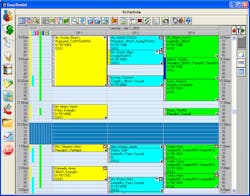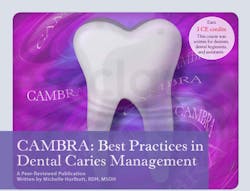Step Next: anticipate, prepare, and accomplish your way to success (Part 2)
7 Strategies to Help Achieve Clinical Success in Dental Hygiene
In the previous RDH eVillage FOCUS newsletter, my article entitled “7 Strategies to Help Achieve Goals in Dental Hygiene and Beyond” illustrated hindsight 20/20 advice which I wish I could tell my 16-year-old self prior to beginning my career in dental hygiene. These are helpful tips to provide a path toward expanding a career beyond clinical practice. However, many of us may have no desire to explore outside the clinical setting, which is completely commendable and admirable on many levels! Those who strive to perform their best clinically keep our profession strong and our patients fortunate.Part 2 is dedicated to dental hygienists who would like to escalate their careers as clinical practice leaders and contribute toward their practice growth and professional development. These tips and strategies were lessons I have learned and adapted throughout my career. As a clinical consultant and former hygiene director, I coached hundreds of hygienists to identify the needs of their patients and present individualized treatment according to their individual risk factors. Here are 7 strategies to help dental hygienists achieve clinical success and contribute to practice growth:1. Prepare ahead of time. Never underestimate the power of reviewing your patients’ charts ahead of time, ideally one week before they are scheduled. Whether you are new to your patient or have seen your patients for years, always look at each patient through new eyes. Do you see anything on their medical history that may impact on their oral health? Do you see bone loss on their x-rays? What were the probe readings previously? Any areas of bleeding? Any areas of “watch” from before? Caries risk? Be sure to write all these findings down or use a checklist to help identify areas of concern and plan on addressing these issues if they are still present on the day of their visit. They’ve already been warned before, plan to take action! If they are healthy on their visit, celebrate it with your patients! Share these findings with your doctor and team during your morning huddle and develop a plan so everyone is on the same page.
2. Be an active, critical contributor to your morning huddles. Hygienists are a critical component to a practice’s success. You are the keeper of important and crucial information that are presented in your patients’ charts during their recare visits. Your charts tell the patient's story and will prepare you on how you will be anticipating their visit. Patients who are scheduled for Periodontal Maintenance appointments but not yet due for a periodic evaluation are often overlooked on their outstanding restorative needs. Be sure to prepare your doctor about any unscheduled restorative treatment needs from previous visits and try to anticipate same-day treatment whenever possible.3. Support your doctor’s previously diagnosed, unscheduled treatment. You have exclusive time with your patient to discuss all their oral health needs. Use an intraoral camera or a hand mirror to review the areas of concern from their previous visit as early in the appointment as possible. If you have an assistant, they can help, too. Provide visuals early in the appointment (display on the screen or print a picture they physically hold in their hand) to reinforce the urgency of their needs. When you physically involve your patients, they are often their own advocates to schedule treatment ASAP.4. Probe every patient, every time. If you don’t measure it, you can’t manage it. Patients don’t only show disease once a year. What if you could prevent bone loss by nipping periodontal disease in the bud early? Or better yet, address gingivitis from progressing to perio? The by-product for treating your patients comprehensively is that you will be growing your schedule and your practice’s bottom line, too.5. Anticipate and build the schedule. Scheduling same-day treatment is extremely beneficial for the patient. They made a commitment to see you, make it easy for them by preparing time blocks to accommodate them during your morning huddle. Take ownership of your schedule and help build it toward your daily goal by initiating treatment on the day you identify it and know your next opening to bring them back.
6. Incorporate salivary diagnostics and CAMBRA into your practice. Take the guesswork out of understanding your patient’s true root cause for their conditions and treat according to their individual risk factors. You wouldn’t blindly start a course of antibiotics to treat strep throat without a throat culture, right? Use evidence-based science and research as a credible and ethical approach toward helping patients take better control of their oral and overall health.
**
7. Don’t limit your practice to teeth and gums. Are you asking patients if they snore? Are you screening for oral cancer? Do you screen for orthodontia, orofacial myology or TMJ needs? Are you asking what they would like their ideal smile to look like? Do you provide nutritional counseling? Do you ask about tobacco use? Do you provide a shade guide and compare their existing shade a brighter shade and see if they are interested in whitening?When you ask patients what is important to them and tailor your treatment plan with their end result in mind, it’s a win:win situation for everyone and patients will be more likely to return. Educate and involve your patients every step of the way. Remind your patients of any unscheduled treatment; failure to do so may risk your credibility (why was it a cavity 6 months ago and nothing mentioned about it today?) and risk your patient’s trust in you. By treating your patients according to their risk factors, your practice will grow considerably and your patients will benefit to have you as their comprehensive advocate.RELATED |Foundation of caries management remains unchanged ** Editors’ Note: For a CE course on CAMBRA, visit: http://www.rdhmag.com/etc/medialib/new-lib/rdh/site-images/volume-31/issue-10/1110RDH095-109.pdf.More by Dona Schulz:Step Next: anticipate, prepare, and accomplish your way to success (Part 1)
7. Don’t limit your practice to teeth and gums. Are you asking patients if they snore? Are you screening for oral cancer? Do you screen for orthodontia, orofacial myology or TMJ needs? Are you asking what they would like their ideal smile to look like? Do you provide nutritional counseling? Do you ask about tobacco use? Do you provide a shade guide and compare their existing shade a brighter shade and see if they are interested in whitening?When you ask patients what is important to them and tailor your treatment plan with their end result in mind, it’s a win:win situation for everyone and patients will be more likely to return. Educate and involve your patients every step of the way. Remind your patients of any unscheduled treatment; failure to do so may risk your credibility (why was it a cavity 6 months ago and nothing mentioned about it today?) and risk your patient’s trust in you. By treating your patients according to their risk factors, your practice will grow considerably and your patients will benefit to have you as their comprehensive advocate.RELATED |Foundation of caries management remains unchanged ** Editors’ Note: For a CE course on CAMBRA, visit: http://www.rdhmag.com/etc/medialib/new-lib/rdh/site-images/volume-31/issue-10/1110RDH095-109.pdf.More by Dona Schulz:Step Next: anticipate, prepare, and accomplish your way to success (Part 1)
Dona Schulz, RDH, BS, MBA, is a Senior Consultant with Step Next Consultants, LLC with experience in every facet of the dental practice focusing on team synergy, increasing practice value and advanced clinical coaching www.StepNextConsultants.com.





